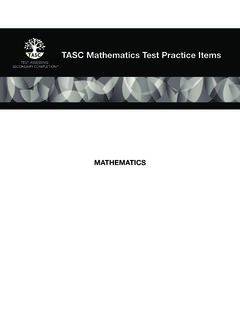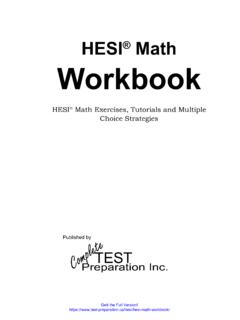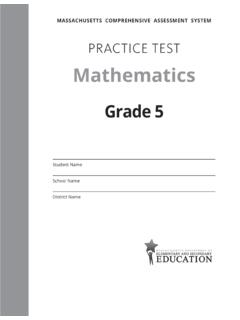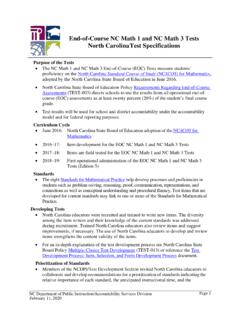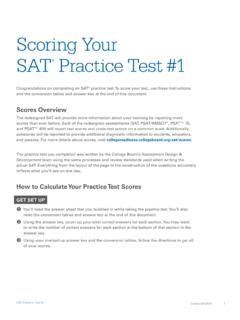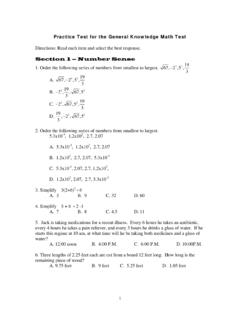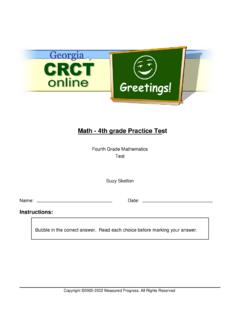Transcription of Educating All Students (EAS) Practice Test*
1 *Adapted from Practice materials developed by Brooklyn College. Educating All Students (EAS) Practice Test* Exhibit 1 Class Description Mr. Jones teaches seventh-grade mathematics. Although most of his program consists of general education classes, one is designated as an Integrated Co-Teaching (ICT) class. His co-teacher for that class, Ms. Smith, is a certified special education teacher. Although this is the first year that the two teachers have worked together, they have developed three teaching strategies that they use most often. In the first model, the two teachers each teach segments of the lesson to the entire class, often offering a variety of strategies to solve specific mathematical problems or concepts.
2 During parallel teaching, the two teachers teach the same concept but split the class into two groups, with each teacher being responsible for one of the groups. Lastly, during some lessons, one of the teachers is responsible to teach the lesson to the entire class while the other teacher rotates around the room assisting individual Students . The ICT class consists of 25 Students . Seventeen of them are general education Students and receive no special education services, while eight of the Students have Individualized Education Programs (IEPs). Of the eight Students , five are classified as having a learning disability, one is classified as other health impaired, one is classified as emotionally disturbed and one as hearing impaired.
3 Jill, one of the Students classified as learning disabled, has strong receptive and expressive language skills. Her main deficit is in the area of visual motor integration, which manifests itself by Jill s inability to copy from the board, poor handwriting, trouble aligning numbers when completing math problems and inability to copy shapes and forms. Tom is classified as other health impaired and has been medically diagnosed as having attention deficit/hyperactivity disorder (ADHD). He is on grade level in mathematics, however, he frequently leaves his seat without permission and has difficulty focusing on tasks for extended periods of time.
4 Sam is classified as emotionally disturbed. He is on grade level in most subjects, but does have difficulty getting along with within a group of peers. He is frequently able to work with one peer at a time, but, if he becomes frustrated, he will begin to argue and/or fight. He often does not complete assignments and/or homework. *Adapted from Practice materials developed by Brooklyn College. Exhibit 2 Except from Informal Classroom Observations of Jill, Tom and Sam by Ms. Smith Jill requires significant support in activities requiring copying, cutting with a scissor on a line, comparing and contrasting objects or shapes, and aligning numbers in a math problem.
5 For example, when given a multi-digit multiplication problem, she is unable to align the numbers; therefore her answers are often incorrect. When shown a geometric shape, she is unable to reproduce it accurately. Recently she was shown a parallelogram and asked to reproduce it on another sheet of paper. Although the resulting shape resembled the model, the lines were not straight and were not to scale. Tom s major challenge seems to be his inability to remain on task long enough to complete assignments. He is easily distracted by any activity that occurs in the classroom. Recently, I timed the amount of time he was able to remain seated and focused on math examples.
6 Out of a 45-minute period, Tom was on task a total of 22 minutes. When Sam has difficulty with a task, he often responds in a negative manner. Recently, he was working in a small group on a task, when he began to scream at the other group members, push his chair and walk out of the room. When he returned to the room, he sat at his desk with his head down, refusing to do any work. Approximately seven minutes later, he sat up and said he was ready to complete his work by himself, which he did. *Adapted from Practice materials developed by Brooklyn College. Exhibit 3 Excerpt from Mr. Jones Draft Lesson Plan Topic: Geometry Standards: Know the formulas for the area and circumference of a circle and use them to solve problems; give an informal derivation of the relationship between the circumference and area of a circle.
7 (NYCCLS M 4) Lesson Objective: Students will be familiar with the terms circumference , center point , radius , and diameter . Students will be able to solve problems involving radius, diameter and circumference. Vocabulary: circumference, center point, radius, diameter Materials: String, rulers, various circular objects Lesson Component Activity Introduction Have a circle drawn on the board with arrows pointing to specific parts of the circle (radius, diameter, circumference and center point). Have Students copy the circle and label the parts of the circle. As a class, write and agree upon the labels for the parts of a circle.
8 Small Group Activity Have Students use the string and a ruler to measure the circumference of a circle, in centimeters, of an object on their table. Students should trace circles on a sheet of paper and fold the paper in half two times to find the diameter of the circle. Have Students write down their measurements and find the ratio of the circumference to the diameter. Discuss student findings, and share answers in class. Ask, What do you notice about the ratio of the circumference to the diameter? The answer should be about centimeters, also known as . Class Activity Have Students write the formulas for the following parts of a circle and review a number of examples: Radius (1/2 d) Diameter (2r) Circumference ( d or 2r ) Assessment Students will complete a number of examples involving the above formulas.
9 *Adapted from Practice materials developed by Brooklyn College. 1) When the teachers implement parallel teaching A. the two groups of Students should always remain the same for consistency B. Mr. Jones should work exclusively with the general education Students while Ms. Smith works exclusively with the Students with IEPs. C. the two groups of Students should be fluid, flexible and heterogeneous based on individual student needs D. Ms. Smith should have fewer Students in her group than Mr. Jones because he is the content expert 2) In addressing Sam s behavioral concerns, first A. Sam should be punished for his behavior B.
10 A Functional Behavioral Assessment must be conducted and a Behavior Intervention Plan developed for Sam C. Sam should be sent to the administrator when he does not follow class rules D. Sam should be positively reinforced when he demonstrates appropriate behavior 3) The least effective strategy to assist Tom in the classroom would be to A. assign assignments that are brief B. allow for movement during the lessons C. provide a variety of activities within the lesson D. have Sam work with groups of other Students for the entire period 4) One of the Students in the class that is classified as having a learning disability has difficulty following directions and understanding new concepts.

